![]()
![]()
![]()
Use LEFT and RIGHT arrow keys to navigate between flashcards;
Use UP and DOWN arrow keys to flip the card;
H to show hint;
A reads text to speech;
30 Cards in this Set
- Front
- Back
|
Which hormone is critical for stimulating brooding and development of the crop sac in ring doves?
|
Prolactin.
|
|
|
Parental behavior
|
any behavior that contributes directly to the survival of fertilized eggs or offspring that have left the body of the female.
|
|
|
ovariectomy _____________ nest building and incubation behaviors in FEMALE ring doves.
|
(fill in the blank) eliminates.
|
|
|
Gonadectomy ____________________ nest building or incubation behaviors in MALE ring doves.
|
(fill in the blank). does not affect
|
|
|
which hormone/hormones restores nest building and incubation behaviors in FEMALE ring doves?
|
estradiol and progesterone.
|
|
|
concaveation
|
a type of sensitization of adult nonparental rodents to pups by daily exposure. E.g. A virgin female rodent starts to show adequate mothering traits via repetitive exposure to young animals, regardless of the fact that she has no previous experience.
|
|
|
hormone which stimulates corticosterone secretion.
|
prolactin.
|
|
|
Which area of the brain is critical for the expression of rat maternal behavior?
|
MPOA (medial preoptic area).
|
|
|
Which brain area inhibit the expression of maternal behavior?
|
amygdala.
|
|
|
Parental investment theory
|
Energy, resources, and risk that a parent uses for the benefit of their offspring.
|
|
|
What happens when not enough parental investment and care?
|
Offspring die because of reduced reproductive fitness.
|
|
|
What happens when too much parental investment and care?
|
parents and offspring suffer because offspring have detriment or parent loses time and resources for itself.
|
|
|
Maternal behavior
|
behaviors exhibited by the females towards the young, or taking care of young.
|
|
|
Paternal behavior
|
behaviors exhibited by the males towards the young, or taking care of young.
|
|
|
Alloparental behavior
|
Parental behaviour exhibited by an individual to young to which it is not parentally related. E.g other helpers like sisters, brothers etc.
|
|
|
Altricial young
|
Altricial >> Hatched with eyes closed, with little or no down, incapable of departing from the nest, and fed by the parents.
|
|
|
Semi-altricial young
|
Semi-altricial >> Covered with down, incapable of departing from the nest, and fed by the parents.
|
|
|
Semi-precocial young
|
Semi-precocial >> Hatched with eyes open, covered with down, and capable of leaving the nest soon after hatching (they can walk and often swim), but stay at the nest and are fed by parents.
|
|
|
Precocial young
|
Precocial >>> Hatched with eyes open, covered with down, and leave the nest within two days.
|
|
|
Parental behavior in birds typically includes ________________________.
|
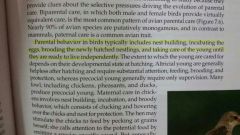
(page 341 in textbook).
|
|
|
_____________ (hormone) is critical for stimulating brooding and development of crop sac in ring doves.
|
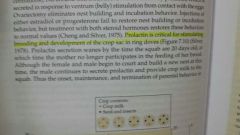
Prolactin. page 344 in textbook.
|
|
|
What are the 2 distinct processes in sheep maternal behavior?
|
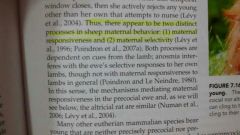
Maternal responsiveness and maternal selectivity. page 353 in textbook.
|
|
|
Removal of ____________ during hysterectomy leads to rapid regression of the corpora lutea and subsequent reductions of blood concentrations of progesterone.
|
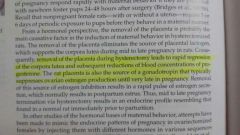
placenta. page 360 in textbook.
|
|
|
Where is maternal behavior integrated and consolidared at? Inhibited at?
|
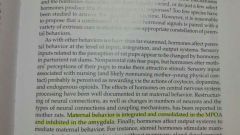
integrated and consolidared at >> MPOA.
Inhibited at >> amygdala page 387 in textbook. |
|
|
Parental behaviors are mediated by hormones via their effects on?
|
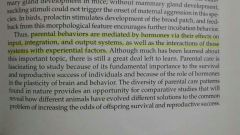
page 387 in textbook.
|
|
|
Hormones or concaveation probably act to disinhibit the amygdala, thus permitting the occurence of ____________ behavior.
|

maternal. page 389 in textbook.
|
|
|
The onset of maternal behavior in rats is MEDIATED by?
|
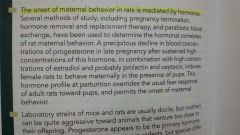
Hormones. page 388 in textbook.
|
|
|
Kyphosis VS. lordosis
|
Kyphosis (opposite curvature of spine as compared to lordosis)>> the normal convex curvature of the spine as it occurs in the thoracic and sacral regions.
Lordosis>> Inward concave curving of the cervical and lumbar regions of the spine is called lordosis. |
|
|
List some examples of pup directed behavior.
|
retrieval of young to the nest site, grouping the young together, anogenital licking to stimulate micturition and defecation.
|
|
|
List some examples of non-pup directed behavior.
|
nest building, placentophagia, and defense of the young.
|

